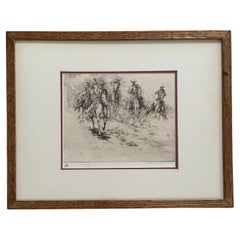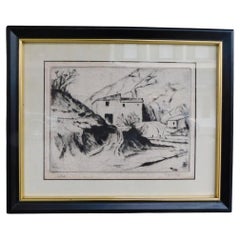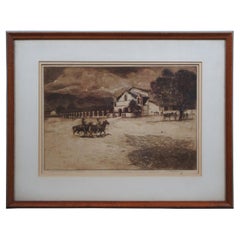Edward Borein Wall Decorations
to
1
1
Height
to
Width
to
1
1
1
1
1
1
1
1
2
435
301
286
282
Creator: Edward Borein
Vintage Dry Point Etching "Going to the Wagon #1" with Doodle by Edward Borein
By Edward Borein
Located in San Diego, CA
Vintage dry point etching "Going to the Wagon, No. 1" with original pencil doodle by noted western artist, Edward Borein, circa early 1900s. The piece is hand signed in pencil by the artist in the lower right and contains a small original pencil doodle in the lower left of a cowboy on a horse. The image (plate mark) is 9.875" x 7.875 and the piece is presented in a custom oak frame measuring 19" x 15.25" with a double cut cream mat. Overall, the etching is in very good vintage condition. This outstanding work is also titled "The Texans" and is extremely rare with the small doodle sketch by Borein. #4452
Born in San Leandro, California, Edward Borein became one of the most popular artists of western scene painting, equally adept at ink drawing, watercolor, and etching.
He was raised in San Leandro, a western cow town, in a family where his father was a county politician. Edward had many childhood memories of herded cattle and their cowboys, which he began sketching at the age of five. He was educated in the Oakland, California schools, and at the age of 17 began working on a ranch near Oakland and then drifted and sketched as a working cowboy throughout the Southwest, Mexico, and Guatemala. It was said that he practiced his art on anything he could find from bunkhouse walls to scraps of paper. At age 19, he enrolled at the San Francisco Art School, his only formal art training, and there he met Jimmy Swinnerton and Maynard Dixon who encouraged him in his art career. The first person to purchase his work was Charles Lummis, editor of The Land and Sunshine magazine in California, and the two became life-long friends. Borein and Lucille Maxwell were married in the Lummis home. Borein, a typical westerner in dress and manner, also became close friends with Charles Russell, actor Will Rogers, and President Theodore Roosevelt. Borein often traveled north to visit Russell in Great Falls, Montana and to travel among Indian tribes. In 1899, Borein visited Arizona while returning from Mexico. By 1902, he was a successful illustrator in San Francisco for the San Francisco Call, and in 1907 to enhance his illustration skills, went to New York to learn etching techniques. There he enrolled in the Art Students League and was a student of Child Hassam. In the theatre district, he opened a studio that became a gathering place for 'lonesome' westerners such as Charles Russell, Will Rogers, Olaf Seltzer...
Category
Early 20th Century American Edward Borein Wall Decorations
Materials
Paper
Related Items
"Nude Male with Hand to Chest, " Drawing by Raoul du Bois
By Raoul Pene du Bois
Located in Philadelphia, PA
Powerful and eloquent, this drawing by Raoul Pene du Bois showcases his mastery of the human figure, expressed with his usual Mannerist approach -- all elongated limbs and stylized p...
Category
1940s American Art Deco Vintage Edward Borein Wall Decorations
American Dry Point Engraved Etching Italian House on Hill Side, A. Hutty C 1920
By Alfred Hutty
Located in Charleston, SC
American dry point engraved landscape etching Italian House on Hill Side, Alfred H. Hutty, Early 20th century
Category
1920s American Modern Vintage Edward Borein Wall Decorations
Materials
Paper
$2,800
H 9 in W 11.25 in D 1 in
Vintage Historical Architectural Landscape Etchings - Original Set of 4, Framed
Located in Cookeville, TN
Beautiful & rare complementary collection of 4 Antique Historical etchings in matching frames by 4 different respected artists. 3 etchings signed in pencil.
1) Titled "Dinkelsbuhl House" by Louis Rosenberg (American, 1890–1983).
This Drypoint etching with a rich burr, was created and printed in 1928.
Pencil signed in the lower right. 12"w x 14"t.
Rosenberg studied architecture at the University of Oregon before moving into architectural etching, studying at the American Academy in Rome and the Royal College of Art in London. The majority of his work was of European buildings with historic significance.
Very fine condition, edition limited.
2) Titled "Misty Morning" by Winifred Austen (English, 1876-1964). An absolutely charming and beautiful quality signed 'Modern British' drypoint etching depicting American Wigeon on the wing, by perhaps the most renowned bird artist of the 20th century, Winifred Austin...
Category
Mid-20th Century European Edward Borein Wall Decorations
Materials
Glass, Wood, Paper
$1,295
H 16.5 in W 19 in D 0.75 in
1960s Etching Titled, Signed Numbered "The Underworld" 4/10 by Artist H. Valoff
Located in Monrovia, CA
Vintage 1960s original etching titled, Signed and numbered "The Underworld" #4/10 H. Valoff 1960s.
1960s original etching by artist H. Valoff is framed and ready to hang.
The und...
Category
Mid-20th Century American Edward Borein Wall Decorations
Materials
Other
$2,200
H 25.5 in W 25.5 in D 0.5 in
James Jacques Joseph Tissot "Soirée d'été" 'Summer Evening' Etching & Dry Point
By James Tissot
Located in Los Angeles, CA
A fine French 19th century etching and drypoint Titled "Soirée d'été" (Summer Evening) by Jacques Joseph Tissot (French, 1836-1902) depicting Mrs. Kathleen Newton resting on a lounge chair. Signed and dated (l/l): J.J. Tissot, 1881 in the plate. Under the mat, the front of the sheet inscribed in pencil with a '1' in a circle, the verso of the sheet with old price inscription "450-" in pencil. Circa: 1881-1882.
Measures: Plate Height: 9 inches (22.9 cm)
Plate Width: 15 1/2 inches (39.4 cm)
Sheet Height: 14 1/2 inches (36.8 cm)
Sheet Width: 20 5/8 inches (52.4 cm)
Frame Height: 19 inches (48.3 cm)
Frame Width: 24 1/2 inches (62.2 cm)
Frame Depth: 1 1/8 inches (2.9 cm)
Literature:
Wentworth 56. Note: Tissot's from 1881 is said to depict his lover, the Irish divorcee Mrs. Kathleen Newton, resting on a lounge chair.
Provenance:
Private collection, Los Angeles, California
Jacques Joseph Tissot (French, 15 October 1836 – 8 August 1902), Anglicized as James Tissot, was a French painter and illustrator. He was a successful painter of Paris society before moving to London in 1871. He became famous as a genre painter of fashionably dressed women shown in various scenes of everyday life. He also painted scenes and characters from the Bible.
Jacques Tissot was born in the city of Nantes in France and spent his early childhood there. His father, Marcel Théodore Tissot, was a successful drapery merchant. His mother, Marie Durand, assisted her husband in the family business and designed hats. A devout Catholic, Tissot's mother instilled pious devotion in the future artist from a very young age. Tissot's youth spent in Nantes likely contributed to his frequent depiction of shipping vessels and boats in his later works. The involvement of his parents in the fashion industry is believed to have been an influence on his painting style, as he depicted women's clothing in fine detail. By the time Tissot was 17, he knew he wanted to pursue painting as a career. His father opposed this, preferring his son to follow a business profession, but the young Tissot gained his mother's support for his chosen vocation. Around this time, he began using the given name of James. By 1854 he was commonly known as James Tissot; he may have adopted it because of his increasing interest in everything English.
In 1856 or 1857, Tissot travelled to Paris to pursue an education in art. While staying with a friend of his mother, painter Elie Delaunay, Tissot enrolled at the Ecole des Beaux-Arts to study in the studios of Hippolyte Flandrin and Louis Lamothe. Both were successful Lyonnaise painters who moved to Paris to study under Jean-Auguste-Dominique Ingres. Lamothe provided the majority of Tissot's studio education, and the young artist studied on his own by copying works at the Louvre, as did most other artists of the time in their early years. Around this time, Tissot also made the acquaintance of the American James McNeill Whistler, and French painters Edgar Degas (who had also been a student of Lamothe and a friend of Delaunay), and Édouard Manet.
In 1859, Tissot exhibited in the Paris Salon for the first time. He showed five paintings of scenes from the Middle Ages, many depicting scenes from Goethe's Faust. These works show the influence in his work of the Belgian painter Henri Leys (Jan August Hendrik Leys), whom Tissot had met in Antwerp earlier that same year. Other influences include the works of the German painters Peter Von Cornelius and Moritz Retzsch. After Tissot had first exhibited at the Salon and before he had been awarded a medal, the French government paid 5,000 francs for his depiction of The Meeting of Faust and Marguerite in 1860, with the painting being exhibited at the Salon the following year, together with a portrait and other paintings.
Émile Péreire supplied Tissot's painting Walk in the Snow for the 1862 international exhibition in London; the next year three paintings by Tissot were displayed at the London gallery of Ernest Gambart.
In about 1863, Tissot suddenly shifted his focus from the medieval style to the depiction of modern life through portraits. During this period, Tissot gained high critical acclaim, and quickly became a success as an artist. Like contemporaries such as Alfred Stevens and Claude Monet, Tissot also explored Japonisme, including Japanese objects and costumes in his pictures and expressing style influence. Degas painted a portrait of Tissot from these years (Metropolitan Museum of Art, New York), in which he is sitting below a Japanese screen hanging on the wall.
Still on Top, 1873
Tissot fought in the Franco-Prussian War as part of the improvised defense of Paris, joining two companies of the Garde Nationale and later as part of the Paris Commune. His 1870 painting La Partie Carrée (The Foursome) evoked the period of the French revolution. Either because of the radical political associations related to the Paris Commune (which he was believed to have joined mostly to protect his own belongings rather than for shared ideology), or because of better opportunities, he left Paris for London in 1871. During this period, Seymour Haden helped him to learn etching techniques. Having already worked as a caricaturist for Thomas Gibson Bowles, the owner of the magazine Vanity Fair, as well as exhibited at the Royal Academy, Tissot arrived with established social and artistic connections in London. Tissot used...
Category
Late 19th Century French Victorian Antique Edward Borein Wall Decorations
Materials
Glass, Wood, Paper
$4,985 Sale Price
22% Off
H 19 in W 24.5 in D 1.13 in
"Reclining Male Nude", Important Drawing by Edward Wolfe, Duncan Grant's Circle
Located in Philadelphia, PA
This important, beautifully rendered drawing of a reclining male nude figure was made by Edward Wolfe, who was born in South Africa but spent much of his career in Great Britain in the company of Duncan Grant and other celebrated gay artists. A year after arriving in England in 1916, Roger Fry invited Wolfe to join the Omega Workshops, where he painted and designed furniture with strong colors influenced by the Fauvist movement. Wolfe connected to Grant and the Bloomsbury Group...
Category
1930s British Art Deco Vintage Edward Borein Wall Decorations
Materials
Paper
$9,500
H 19.75 in W 23 in D 0.75 in
1950 Original Etching by Don Swann, Jr.
Located in Saint Petersburg, FL
Framed etching by Don Swann Jr of Baltimore Skyline. Etched onto Cooper plates before printing.
Swann Jr followed in the footsteps of his father who...
Category
20th Century American Post-Modern Edward Borein Wall Decorations
Materials
Copper
Peter Max Homage to Picasso Volume 5 Etching XX Modern Signed 1993 Framed
By Peter Max
Located in Keego Harbor, MI
Le Shoppe Too in Michigan is offering this modern inspired artwork titled Homage to Picasso Volume 5 Etching XX by Peter Max. Signed in pencil with an a...
Category
1990s Edward Borein Wall Decorations
Materials
Paper
$7,000
H 32.5 in W 29.5 in D 0.75 in
4 Etchings by WG Beal, Marblehead, Rock Port, Folly Point & Annisquam, 1880's MA
Located in Bedford Hills, NY
Set of four etchings by American artist William Goodrich Beal, circa 1880s. Scenic Massachusetts coastal towns and beaches. All signed in ...
Category
1880s American American Classical Antique Edward Borein Wall Decorations
Materials
Paper
$1,200 / set
H 12 in W 16 in D 0.01 in
1967 Etching Titled, Dated, Signed "Nocturnal Abode" #3/7 by Artist H Valoff
Located in Monrovia, CA
Vintage 1967 original etching named signed and numbered "Nocturnal Abode" #3/7 H. Valoff 1967.
1967 Original etching by Artist H. Valoff Is Framed And Ready To Hang.
Nocturnal Ab...
Category
Mid-20th Century American Edward Borein Wall Decorations
Materials
Paper
$2,200
H 20 in W 16 in D 1 in
Art Deco Etching a Toureg by Paul Jouve
By Paul Jouve
Located in Miami, FL
Art Deco etching depecting a Camel and its rider by french Artist Paul Jouve entitled Touareg.
Signature: P. Jouve
Category
Early 20th Century French Art Deco Edward Borein Wall Decorations
Materials
Paper
Art Deco Etching a Tangi au Repos by Paul Jauve
By Paul Jouve
Located in Miami, FL
Art Deco etching by Paul Jouvé depicting an Oriental scenery.
Made in France
Circa: 1933
Signature: Jouvé.
Category
20th Century French Art Deco Edward Borein Wall Decorations
Materials
Paper
Previously Available Items
1917 Edward Borein San Antonio de Padua Mission Drypoint Etching
By Edward Borein
Located in Dayton, OH
"Pencil signed antique etching by Edward Borein of the San Antonio de Padua (Saint anthony of Padua) mission in California 1917. “Born in San Leandro, California in 1872, Edward Borein became one of the most popular artists of western scene painting, equally adept at ink drawing, watercolor, and etching.
He was raised in San Leandro, a western cow town, in a family where his father was a county politician. Edward had many childhood memories of herded cattle and their cowboys, which he began sketching at the age of five. He was educated in the Oakland, California schools, and at the age of 17 began working on a ranch near Oakland and then drifted and sketched as a working cowboy throughout the Southwest, Mexico, and Guatemala.
It was said that he practiced his art on anything he could find from bunkhouse walls to scraps of paper. At age 19, he enrolled at the San Francisco Art School, his only formal art training, and there he met Jimmy Swinnerton and Maynard Dixon who encouraged him in his art career.
The first person to purchase his work was Charles Lummis, editor of The Land and Sunshine magazine in California, and the two became life-long friends. Borein and Lucille Maxwell were married in the Lummis home. Borein, a typical westerner in dress and manner, also became close friends with Charles Russell, actor Will Rogers, and President Theodore Roosevelt. Borein often traveled north to visit Russell in Great Falls, Montana and to travel among Indian tribes.
In 1899, Borein visited Arizona while returning from Mexico. By 1902, he was a successful illustrator in San Francisco for the San Francisco Call, and in 1907 to enhance his illustration skills, went to New York to learn etching techniques. There he enrolled in the Art Students League and was a student of Child Hassam. In the theatre district, he opened a studio that became a gathering place for 'lonesome' westerners such as Charles Russell, Will Rogers, Olaf...
Category
1910s Mission Vintage Edward Borein Wall Decorations
Materials
Paper
Edward Borein wall decorations for sale on 1stDibs.
Edward Borein wall decorations are available for sale on 1stDibs.



